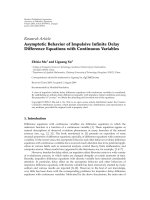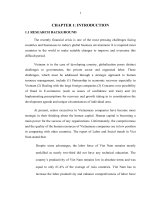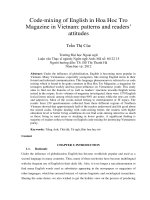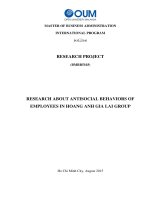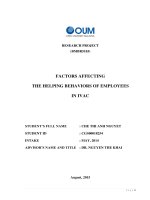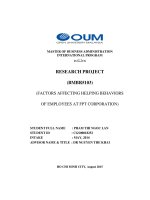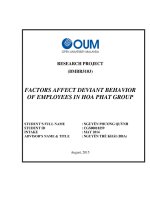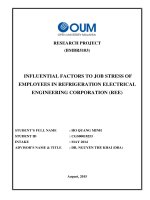Factors affect deviant behavior of employees in hoa phat group
Bạn đang xem bản rút gọn của tài liệu. Xem và tải ngay bản đầy đủ của tài liệu tại đây (987.81 KB, 77 trang )
RESEARCH PROJECT
(BMBR5103)
FACTORS AFFECT DEVIANT BEHAVIOR
OF EMPLOYEES IN HOA PHAT GROUP
STUDENT’S FULL NAME
STUDENT ID
INTAKE
ADVISOR’S NAME & TITLE
: NGUYỄN PHƯƠNG QUỲNH
: CGS00018259
: MAY 2014
: NGUYỄN THẾ KHẢI (DBA)
August, 2015
BUSINESS RESEARCH METHOD
Advisor’s Assessment
-------------------------------------------------------------------------------------------------------------------------------------------------------------------------------------------------------------------------------------------------------------------------------------------------------------------------------------------------------------------------------------------------------------------------------------------------------------------------------------------------------------------------------------------------------------------------------------------------------------------------------------------------------------------------------------------------------------------------------------------------------------------------------------------------------------------------------------------------------------------------------------------------------------------------------------------------------------------------------------------------------------------------------------------------------------------------------------------------------------------------------------------------------------------------------------------------------------------------------------------------------------------------------------------------------------------------------------------------------------------------------------------------
Advisor’s signature
Page 2/77
BUSINESS RESEARCH METHOD
ACKNOWLEDGEMENT
This project consumed huge amount of work, research and dedication. Still,
implementation would not have been possible if I did not have a support of many
individuals and organizations. Therefore I would like to extend our sincere gratitude to
all of them.
First of all I am thankful to Mr Nguyen The Khai (DBA),who has support my class
how to do a research project and apply SPSS software into research. Moreover, he had
even personally gone through and give valuable advised to every individual in class.
With his superior knowledge and experience, the research project would like in quality
of outcomes, and thus his support has been very essential.
I would like to express sincere thanks toward employees of Hoa Phat Group who
devoted their time and knowledge in the implementation of this project.
Nevertheless, I also specially thank to my family and colleagues for their kind cooperation and encouragement which help me in completion of this project.
Once again, I thank very much to all.
Nguyen Phuong Quynh Student
Page 3/77
BUSINESS RESEARCH METHOD
TABLE OF CONTENTS
LIST OF TABLES .......................................................................................................... 8
ABSTRACT ..................................................................................................................... 9
CHAPTER I: INTRODUCTION ................................................................................ 10
INTRODUCTION ABOUT HOA PHAT GROUP .................................................... 10
Overview of the company ............................................................................................ 10
Business activities ....................................................................................................... 12
Business objectives ...................................................................................................... 13
Group structure ........................................................................................................... 14
RESEARCH INTRODUCTION ................................................................................. 16
Research problem statement ....................................................................................... 16
Significance of research ............................................................................................. 17
Research objective ....................................................................................................... 17
Research questions ..................................................................................................... 18
Limitation of research ................................................................................................ 18
Page 4/77
BUSINESS RESEARCH METHOD
CHAPTER II: LITERATURE REVIEW AND HYPOTHESES ............................. 19
LITERATURE REVIEW ............................................................................................. 19
Job Characteristic (Job Overload) ............................................................................. 19
Job Stress ..................................................................................................................... 20
Job Roles (Role Conflict And Ambiguity) .................................................................. 22
Work-Family Conflict ................................................................................................. 24
Deviant Behavior ........................................................................................................ 27
HYPOTHESES .............................................................................................................. 27
RESEARCH MODEL .................................................................................................. 28
CHAPTER III: RESEARCH METHOD .................................................................... 29
DATA COLLECTION METHOD .............................................................................. 29
MEASURE OF EACH CONSTRUCT ....................................................................... 29
Job Overload ............................................................................................................... 29
Job Stress ..................................................................................................................... 31
Role Conflict And Ambiguity ..................................................................................... 33
Work-Family Conflict ................................................................................................. 36
Deviant Behavior ........................................................................................................ 38
Page 5/77
BUSINESS RESEARCH METHOD
CHAPTER IV: ANALYSIS AND RESULTS ............................................................ 41
CRONBACH'S ALPHA (RELIABILITY) ................................................................. 41
Cronbach's Alpha standard applied ........................................................................... 41
CRONBACH'S ALPHA OF CONSTRUCTS ............................................................ 42
Job Overload (JO) ....................................................................................................... 42
Job Stress (JS) ............................................................................................................. 42
Role Conflict And Ambiguity (RC) ............................................................................ 43
Work-Family Conflict (WF) ....................................................................................... 43
Deviant Behavior (DB) ............................................................................................... 44
STATISTICS INFORMATION .................................................................................. 44
Descriptive statistics .................................................................................................... 44
HYPOTHESIS TESTING ............................................................................................ 45
HYPOTHESIS PROPOSED ........................................................................................ 45
CHAPTER V: CONCLUSION .................................................................................... 47
SUMMARY OF THE RESULT .................................................................................. 47
DISCUSSION AND RECOMMENDATION ............................................................. 48
Discussion .................................................................................................................. 48
Page 6/77
BUSINESS RESEARCH METHOD
Recommendation......................................................................................................... 49
LIMITATION ............................................................................................................... 51
REFERENCES .............................................................................................................. 52
APPENDIX .................................................................................................................... 58
Appendix 1: Survey ..................................................................................................... 58
Appendix 2: Presentation ........................................................................................... 70
Page 7/77
BUSINESS RESEARCH METHOD
LIST OF TABLE
Table 1: Group Structure............................................................................................ 14
Table 2: Corporation Structure ................................................................................... 15
Table 3 : Research model ............................................................................................ 28
Table 4: Cronbach 's Alpha - Internal Consistency .................................................... 42
Table 5: Cronbach's Alpha of Job Overload ............................................................... 42
Table 6: Cronbach's Alpha of Job Stress .................................................................... 42
Table 7: Cronbach's Alpha of Role Conflict and Ambiguity ....................................... 43
Table 8: Cronbach's Alpha of Work - Family Conflict ............................................... 43
Table 9: Cronbach's Alpha of Deviant Behavior ........................................................ 44
Table 10: Descriptive statistics ................................................................................... 44
Table 11: Model summary ........................................................................................... 45
Table 12: Coefficients .................................................................................................. 46
Page 8/77
BUSINESS RESEARCH METHOD
ABSTRACT
This purpose of this research in way to find the factors attractive deviant behavior at
Hoa Phat Group.
This research analyses whether or not there is a significant relationship between
Deviant Behavior with Job Overload, Job Stress, Role Conflict and Ambiguity and
Work - Family Conflict among employees in Hoa Phat Group. This research also was
conducted by quantitative method with source data is surveys that it collected via
questionnaire from 268 employees of Hoa Phat Group.
This result of these surveys shall be statistically analyzed by software SPSS version 22.
Hypotheses used this research includes five construct: one dependent construct
(Deviant Behavior) and four independent constructs: Job Overload, Job Stress, Role
Conflict and Ambiguity and Work - Family Conflict.
I hope this research will help CEO and managers of Hoa Phat Group have some
reference in order to have some strategies on how to minimize job stress, conflicts so
that employees can be more efficient and productive in the workplace.
Keywords in this research: Deviant Behavior, Job Overload, Job Stress, Role Conflict
and Ambiguity, Work - Family Conflict.
Page 9/77
BUSINESS RESEARCH METHOD
CHAPTER I: INTRODUCTION
INTRODUCTION ABOUT HOA PHAT GROUP
Overview of the company
Hoa Phat Group is one of the leading private industrial production groups in Vietnam.
Starting with a trading company specializing in construction machines since 8/1992,
Hoa Phat alternately extended to the field of Furniture (1995), Steel Pipe (1996), Steel
(2000), Refrigeration (2001), Real Estate (2001). In 2007, Hoa Phat restructured to a
Group model, in which Hoa Phat Group Joint Stock Company is the parent company
and other member companies and allied companies. In 15/11/2007, Hoa Phat was
officially listed in the Vietnam Stock Exchange with ticker “HPG”.
After the restructure, Hoa Phat has many great strides in which the most prominent
progress was implementing of Hoa Phat steel integrated complex project in Hai Duong
province with the steel production technology from iron ore to steel, and invest to
exploit minerals to create input for steel production. Currently, Hoa Phat is located at
Top 3 of largest steel producers in Viet Nam.
As at 1/2014, Hoa Phat Group has 13 member companies with the major businesses:
Steel production - Mining – Coke production – Real estate - Furniture Manufacturing –
Page 10/77
BUSINESS RESEARCH METHOD
Construction accessories and equipment with many factories in Ha Noi, Hung Yen, Hai
Duong, Lao Cai, Yen Bai, Ha Giang, HCM City, Binh Duong province.
The steel production and related products such as coke, iron ore accounted for over
80% of revenue are key business of the Group. Hoa Phat Furniture is a reputable brand
with the largest market share of office furniture in Vietnam. Besides, real estate,
industrial park, urban area is also another key sector of the Group.
The annual revenue of Hoa Phat Group reaches about USD 900 millions and plan to
reach USD 1,2 billions in 2014.
Hoa Phat Group profile
Transaction name: Hoa Phat Group Joint Stock Company
Business Registration Certificate No.: 0900189284
Charter capital: VND4,886,431,750,000
Address: Pho Noi A Industrial Zone, Giai Pham Commune, Yen My District, Hung
Yen Province
Head Office: 39 Nguyen Dinh Chieu, Le Dai Hanh Ward, Hai Ba Trung District, Hanoi
Phone: (84) 4 62848666
Fax: (84) 4 62833456
Da Nang Branch 171 Truong Chinh, An Khe Ward, Thanh Khe District, Da Nang City
Phone: (84) 511 3721232
Page 11/77
BUSINESS RESEARCH METHOD
Fax: (84) 511 3722833
HCM City Branch: 643 Dien Bien Phu, Ward 25, Binh Thanh District, Ho Chi Minh
City
Phone: (84) 8 62985599
Fax: (84) 8 62987799
Website: www.hoaphat.com.vn
Business activities
1 Trading, exporting and importing iron and steel, materials and equipments for
refining and rolling steel;
2 Producing rolling steel and roof fabrication;
3 Producing steel pipes and galvanized ones, stainless ones;
4 Producing and trading non-ferrous metal and non-ferrous metal scrap;
5 Refining steel and casting iron;
6 Manufacturing and trading coke coal;
7 Mining for metal ores; trading metals, metal ores and metal scrap;
8 Manufacturing and trading construction and mining equipment;
9 Producing interior furniture for offices, households and schools;
10 Manufacturing, trading, assembling, repairing, and maintaining electric,
electronic, refrigeration, civil electric products and air conditioners;
11 Investing and building infrastructure for industrial zones and urban areas;
Page 12/77
BUSINESS RESEARCH METHOD
12 Real estate business.
Business Objectives
Vision
Become the leading industrial production group of Vietnam, operating diversified with
the strong fields including steel production, the traditional industries and real estate
Mission
- Harmonize with the development of society, product always towards benefits of
customers
- Sustainable cooperation, reliable partner, bringing long-term value to shareholders
- Promote talent, wisdom and bring better life to members of the company
- Prospects of investment expansion to contribute significantly to the prosperity of
Vietnam
Page 13/77
BUSINESS RESEARCH METHOD
Group structure
(Table 1: Group Structure)
Page 14/77
BUSINESS RESEARCH METHOD
(Table 2: Corporate Structure)
Page 15/77
BUSINESS RESEARCH METHOD
RESEARCH INTRODUCTION
Research problem statement
Workers today certainly
have
more
stress
due
to
the
increased
responsibility and work added due to smaller workforce. Stress is a serious problem for
front office employees.
This study is to investigate both employees in predicting workplace deviance. Deviant
workplace behavior is a prevailing and costly phenomenon in Hoa Phat Group. It
includes a wide range of negative acts conducted by employees to harm the
organization and its members. The research have identified that deviant workplace
behavior is a very serious problem in Hoa Phat Group. To reducing deviant
organizational behavior because it can be a very disruptive and costly problem in terms
of both the financial toll it takes in the company and the emotional toll it takes in
employees. Deviance has often been recognized as a reaction to frustrating
organizational stressors, such as financial, social, and working conditions found that
the increasing tension in corporations that has resulted from economic changes,
increasing global competitiveness, work - family conflict, role conflict has led to
significant levels of misconduct.
Page 16/77
BUSINESS RESEARCH METHOD
With regard this problem, this study was conducted to examine the relationship
between Deviant Behavior with Job Overload, Job Stress, Work - Family Conflict and
Role Conflict and Ambiguity in Hoa Phat Group.
Significance of Research
With the research results, management of the company could adjust the policy and set
out a strategy to help employees by decreasing work tension. In addition, employees
can balance between work and family in order to enjoy happy life. Besides, it also
improve employee loyalty to the organization and further, contributed to the strengths
of the company increasingly stronger in the future.
Research objective
This study mainly seeks to achieve the following objectives:
1. To investigate the reasons why the employee stress in the workplace.
2. To identify the factors that may to cause deviant behaviors.
3. To suggest some solutions based on research finding to decrease deviant
behaviors.
Page 17/77
BUSINESS RESEARCH METHOD
Research questions
Based on the discussion above, and to accomplish the objective of this study, these
research questions have been formulated:
1. How is the impact job overload on deviant behavior?
2. How is the impact job stress scale on deviant behavior?
3. How is the impact work - family conflict on deviant behavior?
4. How is the impact role conflict and ambiguity on deviant behavior?
Limitation of research
This research will have some limitation because it only focuses related on Hoa Phat
Group employees.
Secondly, this survey conducted in slightly short time. A total of 300 questionnaires,
only 268 responses were usable. The rest 32 questionnaires have most of the questions
leave blank or disappear.
Furthermore, this survey use English which make confusion for the reader when they
answer it.
Page 18/77
BUSINESS RESEARCH METHOD
CHAPTER II: LITERATURE REVIEW AND
HYPOTHESE
LITERATUTE REVIEW
Job Characteristics ( Job Overload)
Job overload represents the weight of the hours, the sacrifice of time, and the sense of
frustration with the inability to complete tasks in the time given. Gmelch et al. (1992)
cite the time, pace, and pressure as major factors contributing to stress and burnout. Job
overload arises as a complex factor in the qualitative studies conducted by Duke (1988)
and Whitaker (1996). Duke interviewed high achieving principals who considered
leaving their jobs.
Having too much to do with too little time to do it is a common perception in the
workplace. This problem, often referred to as work or role overload, can be caused by a
variety of factors. Things such as unrealistic deadlines, lack of appropriate break
periods, and increasingly heightened expectations are common causes of work-related
stress that exist throughout a wide variety of occupations (Shimazu & Kosugi, 2003).
Other harmful factors that are related to work overload include rapid change,
disordered multitasking, uncertainty, and interruptions during work. While it is
possible for many hours of concentration on a well-defined job to have a positive effect
Page 19/77
BUSINESS RESEARCH METHOD
on a person’s mental state, it is also possible for less than an hour of chaos in the
workplace to have a hazardous effect on a person’s health (Zohar, 1999).
People who serve as managers and supervisors are most susceptible to work
overload. One potential explanation for this is the open-ended nature of the managerial
job (Johns & Saks, 2001). The difficulties encountered when trying to juggle the
demands of superiors with the needs of subordinates has the potential to provoke a lot
of stress. Different personality types can also result in different ways of handling a
heavy workload. For example, research indicates that introverts have notably different
coping mechanisms for stress than extroverts (Dormann & Zapf, 2002). These
mechanisms can vary in effectiveness when handling organizational stressors such as
work overload. Another factor that relates to how people are influenced by heavy
workloads is sex. For males, work stress is more strongly related to concerns about
roles in the power structure of an organization, whereas female employees experience
more severe stress when a conflict exists between job requirements and family
relationships (Vagg, Spielberger, & Wasala, 2002).
Job Stress
Job Stress is basically the negative effects of excessive pressure or other types
of demand placed on employees at work. Stress is not a disease it is a state, but if stress
becomes excessive disease for a very long time then it effects on mental and physical
Page 20/77
BUSINESS RESEARCH METHOD
health. According to Safety, (1999) work stress is defined as the harmful physical and
emotional responses that occur when job requirements do not match the worker’s
capabilities, resources, and needs. Managing work related stress is very much
important for any organization because due to this employees will not do
work properly and this will lead the organization towards loss as Palmer, Stephen,
Cooper,& Thomas, (2004) described in his research related to job stress that stressed
workers are also more likely to be unhealthy, poorly motivated, less productive and
less safe at work and their organizations are less likely to succeed in a competitive
market.
Job stress is also called work related stress some studies show that management role is
also very important for job stress Kahn &Quinn, Stress in organization. Role Stress,
(1970) have found in their research that workers in an organization can face
occupational stress through the role stress that the management gave role stress means
anything about an organizational role that produces unfavorable cost for the individual.
There is a strong relationship between work stress and home many researchers did
research on this as Alexandros-Stamatios,(2003) have found in their research that
home-work interface can be known as the overlap between work and home; the two
way relationship involves the source of stress at work affecting home life and vice
versa affects of seafaring on home life, demands from work at home, no support from
Page 21/77
BUSINESS RESEARCH METHOD
home, absent of stability in home life. It asks about whether home problems are
brought to work and work has a negative impact on home life and deviant behaviors.
Multiple task performance is also reason of job stress many studies have been found on
this as Cascio, (1995) and Quick (1997) founded in their research that rapidly changing
global scene is increasing the pressure of workforce to perform maximum output and
enhance competitiveness. Indeed, to perform better to their job, there is a requirement
for workers to perform multiple tasks in the workplace to keep side by side of changing
technologies. Townley, (2007) in his study indicates that the majority of the workers
were unhappy with the current culture where they were required to work extended
hours and manage with large workloads while simultaneously meeting production
targets and deadlines.
Job Roles (Role Conflict And Ambiguity)
The concept of social role draws attention to the fact that different members of the role
set may not hold compatible expectations for the focal person and this may lead to role
conflict. Role conflict can happen when one member of the role set requests the focal
person to behave in two incompatible ways. It can also happen when pressure sent by
one of the role senders to the focal person opposes the pressure sent by another role
sender (Katz and Kahn 1978).
Page 22/77
BUSINESS RESEARCH METHOD
Role ambiguity simply means the focal person doesn't know what he/ she is supposed
to do. A certain amount of information is required for adequate role performance. First,
the focal person needs to know his/her role set and their different expectations; his/her
rights, duties and responsibilities. Second, he/she should know what kinds of activities
would fulfill those responsibilities. Third the focal person should know the possible
consequences of role performance or non-performance for himself/herself as well as
for his/her role set. On top of that the person needs to know the kind of behaviors
which are satisfying or frustrating for his/her personal needs and values. The concepts
of role conflict and role ambiguity were introduced by Kahn et al. (1964) to investigate
the mental health of individuals in organizations due to rapid
changes in technology and the slow process of user' adaptability. In a nationwide study
of male wage and salary workers, they discovered that almost half of them were facing
noticeable role conflict. Since then, research on role conflict and role ambiguity tends
to be on roles for which some polarizations of differences among role senders seemed
likely. Roles like the role of industrial foreman, salesperson, teacher and manager have
been studied and role conflicts have been found to contribute to distress. These effects
were associated with lower levels of job satisfaction, decreased commitment as well as
increased tension and a higher likelihood of leaving the organization (Jackson and
Schuler, 1985). In a more recent study, Floyd and Lane
Page 23/77
BUSINESS RESEARCH METHOD
(2000) investigated the inconsistent expectations that managers face in the renewal
process of their organizations, based on the need to deploy the existing competences
and to create new ones. In another study, Tang and Chang (2010) studied the effects of
role conflict and role ambiguity on employee creativity. Research tends to focus on the
effect of role conflict and ambiguity on the focal person, rather than on members of the
role set, or in this case, of the team. This is particularly relevant for construction
projects where each team member has a very specific skill that is not easily replaced,
should they decide to leave.
Work - Family Conflict
Some of the work-family conflict research has focused on construct measurement,
including the measurement of the direction and process of interaction between work
roles and family roles (Kossek & Ozeki, 1998).
The changing face of the workforce has increased the amount of research looking at
how people manage the demands of both work and family. With both professional and
personal responsibilities, women in particular are faced with a significant challenge
when reconciling these demands. Greenhaus and Beutell (1985) defined work-family
conflict as “a form of friction in which role pressures from the work and family
domains are mutually incompatible in some respects” . Research suggests that people
will spend more time engaged in roles that are most important to them, therefore
Page 24/77
BUSINESS RESEARCH METHOD
leaving less time for other roles, which increases the opportunity for the person to
experience role conflict (Greenhaus & Beutell, 1985).
Greenhaus and Beutell (1985) completed a comprehensive review of extant workfamily conflict research. In the review they described three different types of workfamily conflict: time-based conflict, strain-based conflict, and behavior-based conflict.
Time-based conflict occurs because “time spent on activities within one role generally
cannot be devoted to activities within another role” (Greenhaus & Beutell,1985). Timebased work/family conflict can take two forms. One form of time based work-family
conflict occurs when time obligations from one role make it physically impossible to
fulfill expectations from another role. For example, a scheduled responsibility at work
would make it physically impossible for an employee to stay home to care for a child
who is home sick from school. By the simple fact that people cannot be in two places
at once, fulfilling work responsibilities may not allow for the flexibility needed to meet
family role expectations. Another form of time-based work- family conflict occurs
when pressures from one role create a preoccupation with that role, making it more
difficult to meet the demands of another role. In this form of conflict, a person may be
physically able to complete responsibilities stemming from multiple roles, but an
emotional or mental preoccupation makes this more challenging. This type of timebased work/family conflict can take many forms, depending on the work and family
variables involved. For example, an employee may be preoccupied during a work
Page 25/77
